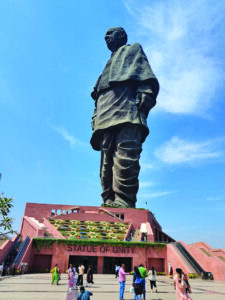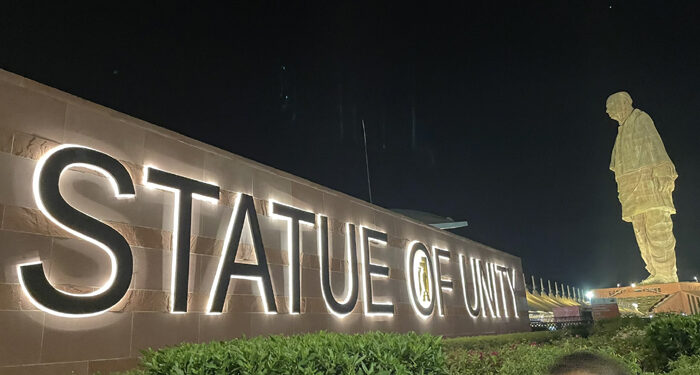KEVADIA, FEB 24
Tamil scholar Thiru Vi Ka used to say “If you have money, spend it,” which means “one should travel to widen his knowledge.” Furthermore, tourism rejuvenates one’s body and mind. When Prime Minister Narendra Modi was the CM of Gujarat, he had a larger vision and grander plans to execute Thiru Vi Ka’s golden words at Statue of Unity by converting it into a hub for tourism with attractions for each age group.

An engineering marvel that bedazzles all
Statue of Unity (SoU), the 182-meter (597 feet) tall statue of statesman Sardar Vallabhbhai Patel – India’s Lauh Purush (Iron Man) – built in between the Satpura and Vindhyachal hill ranges and facing the Gigantic Narmada Dam is an engineering marvel of the era bedazzles the visitors from across the globe.
A fitting tribute to Sardar Vallabhbhai Patel and engineering skills and project management abilities of our engineers, the statue was completed in a record 33 months.
The huge Exhibition Hall at the base of the Statue of Unity uses various media & technology to give an insight into the entire life & achievements of Sardar Patel. His tremendous contribution to the freedom struggle & how he united the provinces into one India is depicted here. pic.twitter.com/Z5lesamTko
— Statue Of Unity (@souindia) February 10, 2023
Encounter with an exact replica of the nation’s unifier Sardar Vallbbhai Patel at a sprawling exhibition gallery situated in the vicinity of the statue of unity. Here, you can capture memories with your near & dear ones. Have you visited these wonders of the world yet? pic.twitter.com/BhgEBa0cYp
— Statue Of Unity (@souindia) January 5, 2023
Explaining in detail about the salient features of the SoU to the visiting Tamil Nadu journalists, Senior Guide Juli Pandya said, “The statue is three times the height of Christ the Redeemer in Rio Dio Janerio, twice the size of Statue of Liberty in New York and nearly 77-feet taller than China’s Spring Temple Buddha statue. Commissioning of the statue to face the Naramada Dam was taken by the Prime Minister Narendra Modi to fulfill the dream of building the dam.
Also Read:
Daily footfall of the tourists thronging the SoU is around 5,000 during lean season and it will increase during summer and holiday/festival seasons, Juli said.
The grandiose plan to build the gigantic statue was taken by the Prime Minister Narendra Modi when he was the Chief Minister of Gujarat in 2010, but his dream come true on his 143rd birth anniversary of the leader – on October 31, 2018.
The statue was built at a whopping cost of over Rs 3,050 crore by an army of over 3,000 workers, including 300 engineers from Larsen & Toubro.
The making of Statue of Unity
#EXCLUSIVE – This is the biggest sculpture that I have ever made in my life. I go the chance to make the tallest statue in the world; I am ecstatic, says the sculptor Ram V. Sutar. | #StatueOfUnity
LIVE UPDATES: https://t.co/83rE1WRwSe pic.twitter.com/WQKzI8quOL
— News18 (@CNNnews18) October 31, 2018
Series of portraits hanged around the SoU museum are telling stories of how the statue has been designed by a team lead by 93-year-old sculptor Ram V Sutar. How the designers of the statue faced two major challenges. One, the Statue of Unity was to be designed based on a real-life photograph of Sardar Patel in dhoti and jacket, unlike the statues of Buddha and Christ, which are imagined depictions covered in robes. In short, the designers of the Statue of Unity had to capture more details than the makers of other comparable structures. Two, in a survey, 15 major Indian bronze foundries were found incapable of executing a project of this size.
To make sure the statue’s face resembles Patel’s facial features, around 2,000 photographs of the leader from archives were studied. To get his posture right, the group working on the statue chose a picture of Patel taken in 1949, arguably one of the most strenuous years of his life.
Using these pictures, Sutar built an 18-feet bronze statue of Patel. Once built, the statue was taken to his birthplace in the town of Karamsad in Gujarat’s Anand district to observe the reaction of the people, including those who had seen him alive. Using the feedback, Sutar built another statue, this time 30-feet tall. After the design was finalised, a full-size digital model of the statue was prepared. Sutar then went to China along with the officials of Sardar Sarovar Narmada Nigam Limited, a Gujarat government owned firm which operates the Sardar Sarovar Dam, to get intricate bronze cladding, which could not be made in India etc.
Chinese technology
World’s largest foundry — the China-based Jiangxi Toqine Metal Crafts Corporation, was tasked with building these cladding, required to give the statue final shape. The sculptor had to visit China four times before the company could move ahead with the production of around 7,000 bronze plates of various sizes, which were welded together at the site of the statue. Techniques such as 3D scanning and computer numerical control production were used for accurate reproduction of minute details. After solving the jigsaw puzzle with oxyacetylene flame (that is, matching and welding), the number of cladding came down to 550. These were affixed onto the structure to give it the final shape.
Part of the statue enclosed inside the 8mm bronze cladding is a two-layered structure. The innermost layer has two 127-metre-high towers made of reinforced cement concrete. These towers rise up to the chest area. The steel frame between the towers and the cladding forms the second layer.
One, unlike the Statue of Liberty and Christ the Redeemer, the Statue of Unity does not have a wider base. A wider base is required to make a structure stable. As Patel wore a Dhoti, the statue is thicker towards the top and thinner at the bottom. This challenge was overcome by keeping the slenderness ratio between the width of the statue and its height to 16:19 — significantly higher than the 8:14 ratio rule that is followed in the construction of high-rise structures.
Two, the base of the statue, below the dhoti-clad legs is about 25-metre high, equivalent to an eight-storey building. This part of the structure houses two massive lifts, which can carry over 25 people to a 135-metre high gallery in just above half a minute. Fitting these vibration-causing machines inside the statue’s two vertical cores, the first of its three layers, was a challenge for the engineers.
Safety, the top-most priority
Three, engineers had to factor in the speed of wind, and the possibility of earthquakes and flood. Being built on an island in the middle of Narmada, the statue will have to face the tunnel effect of winds blowing down the river. The walking pose of the statue opened up a gap of 6.4 metres between the two feet. To deal with these issues, the cladding used in the statue has overlapping panels, which allow it to move vertically and horizontally, to resist earthquake and wind forces. Two 250-tonne mass dampers, which are installed in structures to reduce the amplitude of vibrations, have been used. As a result, the statue is capable of withstanding wind blowing at almost 220 km per hour and surviving earthquakes measuring up to 6.5 on the Richter Scale.
Over 210,000 cubic metres of cement concrete, 18,500 tonnes of reinforced steel, 6,500 tonnes of structural steel, 1,700 tonnes of bronze, and around 1,850 tonnes of bronze cladding, made up of some 565 macro and 6,000 micro panels, were used to build the statue.
Ekta Mall
At present, an Ekta Mall is operational near the Statue of Unity, located about 3.5 km away from the statue at Ekta Nagar in Kevadia. The Ekta Mall – Unity in Handicrafts Diversity is a showroom of handicrafts from different states of India. Spread over 35,000 square-feet area of two floors, the mall has 20 emporiums dedicated to states’ traditional textiles and artisanal handicrafts.
Ekta Nagar
All state governments have been allocated lands at Ekta Nagar to showcase their rich culture and tradition. This in turn will attract more tourists to the respective districts.
With a view to woo tourists, the SoU authorities developed following attractions:
Laser, Light and Sound Show
The laser, light and sound show on the life history of Sardar Vallabhbhai Patel, his contribution to the freedom struggle and unity of the nation were projected on his statue every day evening except on Monday.
River rafting at Sardar Sarovar Nauka Vihar
Get a chance to experience the thrill of river rafting at Khalwani near Statue of Unity. With 6 rapids amidst gushing Narmada waters, this place is a must for adventure seekers. pic.twitter.com/5TVaARmJOY
— Statue Of Unity (@souindia) February 23, 2023
People like adventure can go for thrilling river rafting experience with whirlpools, rapids, twists and turns at the adjoining Panchmmuli Lake at Kevadia. This facility has been created as part of eco-tourism activity.
A voyage on Ekta Cruise is a treasurable memory at Ekta Nagar. Gliding through the calm Narmada waters, tourists can get a beautiful view of the colossal Statue of Unity while enjoying entertaining performances & relishing delicious food.#Ekta_Cruise #EktaNagar pic.twitter.com/LLiJTE4k4K
— Statue Of Unity (@souindia) February 19, 2023
Other attractions are; Ekta Nursery, Arogya Van (Herbal Garden), Tent city on the banks of Sarovar dam, Butterfly Garden, Children Nutrition Park and a jungle ride.
Twinkling lights at Glow Garden make for a cheerful display to make evenings memorable. Enjoy various light fountains & motifs that are perfect for clicking pictures. Explore this place & much more at Ektanagar. Visit soon with friends & family!! pic.twitter.com/kixKUckILb
— Statue Of Unity (@souindia) February 17, 2023
Kevadia is well connected by air, rail and road transport facilities from across the country.
For details, browse: https://statueofunity.in/how-to-reach/ www.soutickets.in, www.gujarattourism.com
Toll Free number – 1800 203 1111
(The Press Information Bureau has arranged the Tamil Nadu media visit of Gujarat)












